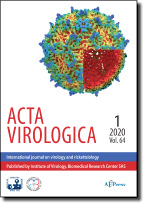Acta Virologica Vol.62, No.4, p.424-434, 2018
|
| Title: Cell-to-cell transmission of lymphocytic choriomeningitis virus MX strain during persistent infection and its influence on cell migration |
| Author: M. Labudová, F. Čiampor, S. Pastoreková, J. Pastorek |
|
Abstract: Lymphocytic choriomeningitis virus (LCMV) can establish in its host a persistent infection, without any prominent symptoms. Even during this infection, when the infectious virions are not released, the virus still disseminates effectively. A very effective and fast way of infection of neighboring cells utilized by many viruses is cell-to-cell transmission. Viruses use different ways of cell-to-cell spread through the extracellular space or by intracellular means through different protrusions. We have found that LCMV strain MX may use three different types of cell-to-cell transport. Firstly, similar to vaccinia virus, it can use actin to propel the virus towards the neighboring cell. Secondly, virus can travel through the intracellular space inside the tunneling nanotubes, that connect the cells even at longer distances and thirdly, the virus may travel on the surface of the membrane of different protrusions connecting two cells. We have also proved that the cells infected by MX strain of LCMV migrate faster than the uninfected cells or cells infected with a different LCMV strain. In accordance with faster migration, the infected cells form more lamellipodia with high expression of keratin 1. In this work, we have introduced three types of cell-to-cell transmission utilized by strain MX of LCMV and showed that even if the cells are not in tight connection, the virus forces them to migrate faster to join the nearest cell. As we show in this work, the virus may use more than one strategy to move to another cell, while each strategy can substitute another. These ways of transmission are very fast and effective and may have a serious impact on the host. Moreover, targeting the cell-to-cell spread, by inhibiting for instance GTPase dynamin, could be an effective way of virus elimination.
|
|
| Keywords: lymphocytic choriomeningitis virus; transmission; migration; keratin 1; nucleoprotein |
|
|
Published online: 23-Nov-2018
|
| Year: 2018, Volume: 62, Issue: 4 |
Page From: 424, Page To: 434 |
doi:10.4149/av_2018_411
|
|
 download file download file |
|
|
|
|
 download file
download file
